Category: used construction machines、 Recycling Equipment、 excavator、 GRINDER、 screen、 soil-recycling、 wheel loader、 road equpment、 aerial platform、 demolition、 auction、 export、 dozer、 crusher、 forestry
Chukyo Juki Official Blog
2020 03.13
Category: used construction machines、 Recycling Equipment、 excavator、 GRINDER、 screen、 soil-recycling、 wheel loader、 road equpment、 aerial platform、 demolition、 auction、 export、 dozer、 crusher、 forestry

Application of mobile soil-recycling
Self-propelled soil reclaimer machines can be seen mainly in highway construction, reclamation and redevelopment, highway construction sites, dredging of ports and rivers (dredging), and soil improvement work. When soil and sand generated from construction work is reused, lime and other additives "cement" are mixed together and used for recycling into environmentally friendly, reusable soil. In dredging work, it is mainly used to remove water from the soil dug from the water and improve it into the soil that can be reclaimed. If we use the embankment which is made by regenerating the waste excavated from construction or dredging, it is convenient because we don't need a place to dispose the waste soil and we don't need to dig the embankment. It is also possible to minimize transportation by truck.
Self-propelled soil-recycling can be used for purposes other than soil recycling because they are like moving plants. In fact, there are cases in which industrial waste treatment companies that handle soil improvement such as sludge use self-propelled soil-recycling in combination with solidification material silos.

Mobile soil-recycling in combination with solidification material silos.
Operation of mobile soil-recycling is difficult.
Self-propelled soil-recycling are highly specialized construction machines, but the structure itself is not so complicated. On the other hand, the quality of the improved recycled soil depends partly on the know-how and skills of field operators, so it can be said that the operation of the self-propelled soil improvement machine requires specialized skills in addition to learning simple operation methods. In order to fully realize the potential of the mobile soil-recycling envisioned by the manufacturer, it is necessary to have a variety of know-how and experience from the setting of the mixer before the work to the quality control of the improved soil after production. It is a work to improve it to recycled soil by mixing a solidifying agent with raw soil, but the soil quality and the amount of water contained in the raw soil differ depending on the site. In addition, the type and amount of the solidifying agent will change depending on the condition of the soil to be recycled and the application of the soil. It is more difficult than you imagine to calibrate and set the amount of solidification agent to the amount of soil flowing on the conveyor to the sensor of the mobile soil-recycling. In Japan, it is often equipped with a recording printer to record mixture of solidification materials, because in some cities there is duty to submit the records of the method of use and the amount of solidification agent added to the local government.
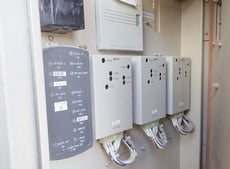 Printers
Printers
Differences between Hitachi and Komatsu of self-propelled soil-recycling
The major manufacturers of self-propelled soil-recycling are Hitachi and Komatsu. We Chukyo-juki handled with Hitachi’s SR-P1200 SR-G2000 SR2000G and Komatsu's BZ120 BZ200 BZ210 -1 G-MODE.
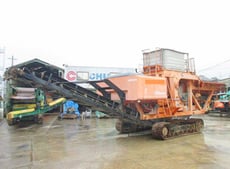

Hitach soil-recycling Komatsu soil-recycling
As for soil-recycling, the method of mixing soil as a raw material is very different between Hitachi machines and Komatsu machines. Each of them has a different field, application and soil quality.
Soil-recycling made by Hitachi, the shaft rotates in two different directions in the mixing chamber , and the attached paddles mix the solidifying agent and the soil of the raw material. The amount of treated soil is large and the improved soil produced is well stirred and good quality. On the other hand, when gravel is mixed in the soil, abrasion becomes more severe, so it is necessary to install anti-abrasion paddles. A solidifying agent is put in a hopper, and it is flexible by bellows fold, so it can be shrunk during transportation. However, when the solidifying agent attached when the hopper shrinks, it may break. The belt conveyor used to throw in the dug soil is made of rubber, so if you put in the soil as a raw material severely, it will wear out and lean one side, but it is y easy to install new one.
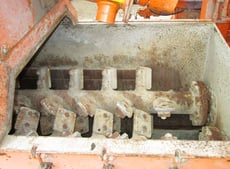
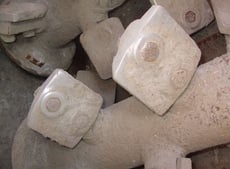
Paddle type mixing chamber Paddle for mixing
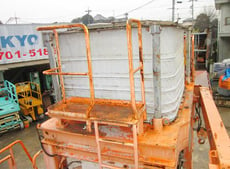
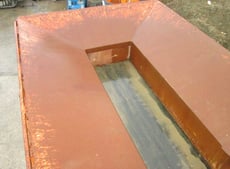
Foldable hopper Belt conveyor type sand hopper
Mixers made by Komatsu rotates cutter cuts the raw material soil while a hammer rotates to smash and mix a solidifying agent.Some models have “after cutters” to cut and mix the soil again just before discharging. Even if there is a big lump of soil, you can cut it down and mix it, so it is helpful preparation more easily. It is workable and powerful when it operators in G-MODE more than normal mode. But if you don't remove the mixed stones properly, it's easy to break the mixing chamber. Hopper for the solidification material hopper is removable and made by iron. It needs to be taken off from main body when transport because it is height too much for transport. But it's made of iron, so it's durable and relatively easy to repair even if it breaks. The conveyor belt is also made of iron, so it is strong against impact and wear. On the other hand, if it gets stuck or worn out, the repair cost may become expensive.
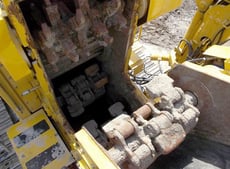
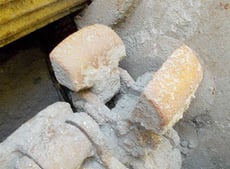
Mixing chamber Mixing hammer

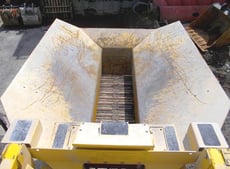
Hopper made by iron Conveyor made by iron
In terms of feature comparison, Hitachi's soil-recycling are good at clay soil and soil including a lot of moisture, while Komatsu's soil-recycling are good at lumps of soil. However, there are sites where soil-recycling is being carried out at a dredging site for raw material soil with a high water content using Komatsu's G-MODE system, and at other sites where scrapped waste materials are first crushed with a roll crusher and then removed with a one-off production screen and processed with Hitachi SR-G.
In Korea, it is mainly used at the site of housing construction. Residential land development is being carried out in the suburbs of big cities such as Seoul city to respond to the increasing demand for housing construction, but there are many sites in coastal areas where ground is very soft and swamps and wetlands are abundant. Therefore, soil improvement is being carried out under the guidance of the government, but because there are no soil-recycling made by Korean manufacturers, Japanese soil-recycling have been introduced. Actually, there is no official export route for Japanese soil-recycling, in another word, there is no export route for new cars, so used machine trading companies like us often mediate. Hitachi's paddle mixer-type machines are selling well in Korea, probably because of the large amount of clay in the soil that will be improved. It is evaluated as "The Hitachi SRG 2000 is the best!".Komatsu's BZ 210 is highly popular in China, and Chukyo-Juki has delivered this model.
In Australia, self-propelled mobile soil-recyclings are used to improve polluted soil, not soft soil. In Australia, where soil tests are required at the time of housing construction, there is a need for soil improvement using soil-recycling because construction permits are not granted for highly acidic land. In Japan, where the purpose is to harden soil, cementitious and limestone materials are used as solidifiers for soil improvement, but in Australia, the purpose is to neutralize acidic soil, so it seems that different additives with unique combinations are used.
Some people in Canada want mobile soil-recycling for soil improvement of polluted soil, and also we exported mobile soil-recycling to the United Kingdom.
I don't hear much about manufacturers that produce soil-recycling overseas, so self-propelled soil-recycling may be unique to Japan.
Precautions when introducing used equipment
The disadvantage of purchasing a used self-propelled mobile soil-recycling is that the condition of not only the self-propelled mobile soil-recycling but also the used machine varies depending on the usage and maintenance conditions of the machines. Therefore, it is important to purchase from a reliable supplier not only for the price but also for maintenance and usage.
When you buy a self-propelled mobile soil-recycling, please check if the provided remote controller and radio control are working normally or not, and if the solidifier hopper is stuck or not. Also, many frames have been modified by previous owners to improve their usability, so you should check if they have been modified or not.
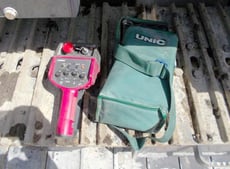
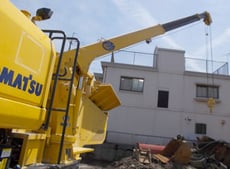
Remote control Crane operated by remote control
In the case of Hitachi's self-propelled mobile soil-recycling, check whether the paddle has worn out, the liner receiving the paddle has worn out, the bearings of the shaft more loosen, and the condition of the mixing chamber. In the case of Komatsu's mobile soil reclaimer, wear and distortion of the hopper (Presence or absence of waving, wear, abrasion, or distortion) and mixing chamber, and wear of the rotary hammer (including shaft) and cutter are checked.
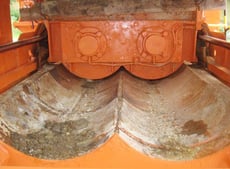
Liner receiving the paddle
Method for maintenance of mobile soil-reclaimer
The self-propelled mobile soil-recycling has a relatively simple structure, but it is equipped with many sensors to produce improved soil according to the setting.
Problems caused by sensors are often serious in the case of self-propelled soil-recycling. Self-propelled soil-recycling are used at many sites to improve soil containing water, and lime or cementitious materials are used as solidification materials. If wet soil or solidification materials are not adhered to the wiring, the covered parts of the wiring may corrode, resulting in disconnection of the wiring, which may result in numerical inspection, failure to operate, or failure to detect abnormalities.
For preventing above, it is effective to remove soil and solidification materials by cleaning after each work, and to take measures against soil and solidification materials such as closing the gap where soil and solidification materials are likely to invade into the wiring. The work site where water-rich soil is treated with an alkaline solidifying agent is particularly susceptible to corrosion, so it is necessary to pay attention not only to the electrical system but also to the corrosion of the machine itself. If a solidifying agent adheres, it must be removed by hand or scraped off with a sandpaper grinder. As a method to remove solidifying agent using the power of chemical reaction, there is a case to use acid toilet detergent, so please try it.
A mixing room is the part that wears out the most quickly when compared with the others. As wear increases, the burden on other parts may increase, leading to serious problems. Therefore, it is necessary to clean and maintain the parts after use to check for wear by sight regularly and to replace worn parts.
Komatsu's mobile soil-recycling mixes soil by striking it with a cutter and a hammer, so it can start work without pretreatment even if the input soil is highly contaminated with sand and gravel. However, if there is a large amount of large stones or gravel, there may be dents in the mixing chamber or the shaft may become distorted. Therefore, it is necessary to take measures to reduce the load on the mixer, such as removing a certain amount of pebbles from the screen. In particular, it is effective for maintenance to keep photos of new soil cutters and rotary hammers, which are severely worn, showing their condition at the time of introduction, and to keep track of the degree of wear based on them. It is also important to grease the bearings around the shaft firmly.

Screw feeder type solidification material inlet
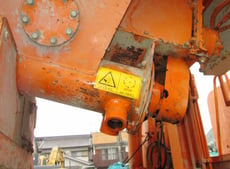
Hardened material inspection port
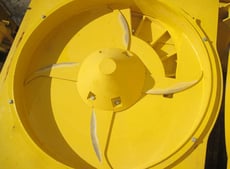
Solidification material supply part
Hitachi's mobile soil reclaimer is a mechanism in which two large paddles with shafts rotate in opposite directions to stir input soil. The bearing that supports the shaft is subject to a load, so apply grease firmly during maintenance. In particular, the bearing opposite to the motor that transmits power tends to wear out quickly. It is necessary to check the noise without fail. Bearings are replaced per 1000 HR, which is quite expensive. The replaceable paddle itself can be easily replaced, but be aware that if the damage spreads to the mounting base, the repair cost will be high. The hopper of the solidifying agent is also the part which needs cleaning especially. Because lime or cement alkaline solidifiers are used, they must be carefully removed by compressors. There is a case that rainwater got into the hopper with a very small amount of solidification material left, and the inside of the hopper became hard. If it sticks and hardens, it will be scraped.
The hopper of Komatsu's mobile soil-recycling is strong because it is made by metal. However, the hopper has fin-shaped supply part that rotates so that the solidifying agent drops evenly. This motor may leak oil. Be careful not to damage the rotation sensor on the other side of the linkage when replacing.
The hopper for solidification material of Hitachi is folded and stored in the bellows type. However, the bellows part did not stretch during use due to insufficient cleaning, and in some cases, it was stretched and damaged. In addition, the supply method of the solidifying agent is screw feeder type, and cleaning may be difficult because the structure is stored in the cover. In the new mobile soil-recycling, the inspection and cleaning opening has been added and improved, but in the mobile soil-recycling,, it is necessary to remove the bolt every time cleaning.
The tub grinder is used to crush stumps and roots, and the horizontal grinder is used to crush waste wood that has be dismantled and elongated wood.
Daily cleaning is really important.

MARUMORI-KUN